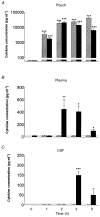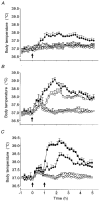Circulating interleukin-6 mediates the febrile response to localised inflammation in rats
- PMID: 10922015
- PMCID: PMC2270040
- DOI: 10.1111/j.1469-7793.2000.00653.x
Circulating interleukin-6 mediates the febrile response to localised inflammation in rats
Abstract
Interleukin (IL)-6 is an important mediator of the host response to disease and has been proposed, largely based upon circumstantial evidence, as the principal endogenous circulating pyrogen responsible for activating CNS mechanisms in fever during infection and inflammation. In the present investigation, we studied the role of peripheral IL-6 in fever and its relationship with IL-1, itself an important endogenous pyrogen and a potent stimulus of IL-6 production. Injection of lipopolysaccharide (LPS) into a sterile, subcutaneous air pouch (i.po.) in rats evoked an increase in body temperature which peaked at 3 h, and which was abolished in animals pretreated (intraperitoneally) with IL-6 antiserum. The increase in body temperature was accompanied by a significant elevation in concentrations of (immunoreactive) IL-1 and IL-6 at the site of inflammation (pouch), but only IL-6 in the circulation and cerebrospinal fluids. We propose that much of the circulating IL-6 originates at the site of inflammation, since injection of human recombinant (hr)IL-6 (i.po.) was detected (10 min after the injection) in the plasma using an ELISA specific for human IL-6. However, despite the relatively high concentration of IL-6 injected (25 microg kg-1, i.po.), this cytokine had no effect on body temperature when injected alone, but did induce fever when co-injected with a non-pyrogenic dose (when given alone) of IL-1beta, and exacerbated the fever to a pyrogenic dose of IL-1beta. The results from the present study demonstrate that IL-6 is a circulating endogenous pyrogen during LPS-induced fever, which acts in concert with IL-1beta at the local site of inflammation, before entering the circulation. Circulating IL-6 can then activate CNS mechanisms resulting in the development of the febrile response during disease.
Figures




Comment in
-
The afferent signalling of fever.J Physiol. 2000 Aug 1;526 Pt 3:470. J Physiol. 2000. PMID: 10921998
Similar articles
-
Role of endogenous interleukin-1 receptor antagonist in regulating fever induced by localised inflammation in the rat.J Physiol. 2001 Feb 15;531(Pt 1):171-80. doi: 10.1111/j.1469-7793.2001.0171j.x. J Physiol. 2001. PMID: 11179401 Free PMC article.
-
Circulating interleukin-6 induces fever through a STAT3-linked activation of COX-2 in the brain.Am J Physiol Regul Integr Comp Physiol. 2006 Nov;291(5):R1316-26. doi: 10.1152/ajpregu.00301.2006. Epub 2006 Jun 29. Am J Physiol Regul Integr Comp Physiol. 2006. PMID: 16809483
-
The role of local induction of tumor necrosis factor by LPS within a subcutaneous air pouch in the development of a febrile response in guinea pigs.Neuroimmunomodulation. 2000;7(4):169-76. doi: 10.1159/000026435. Neuroimmunomodulation. 2000. PMID: 10810248
-
Cytokines and fever. Mechanisms and sites of action.Ann N Y Acad Sci. 1998 Sep 29;856:83-89. doi: 10.1111/j.1749-6632.1998.tb08316.x. Ann N Y Acad Sci. 1998. PMID: 9917868 Review.
-
Interleukin-1 beta, interleukin-18, and the interleukin-1 beta converting enzyme.Ann N Y Acad Sci. 1998 Sep 29;856:1-11. doi: 10.1111/j.1749-6632.1998.tb08307.x. Ann N Y Acad Sci. 1998. PMID: 9917859 Review.
Cited by
-
The impact of interleukin-6 (IL-6) and mesenchymal stem cell-derived IL-6 on neurological conditions.Front Immunol. 2024 Jun 24;15:1400533. doi: 10.3389/fimmu.2024.1400533. eCollection 2024. Front Immunol. 2024. PMID: 39015561 Free PMC article. Review.
-
NINJ1 mediates inflammatory cell death, PANoptosis, and lethality during infection conditions and heat stress.Nat Commun. 2024 Feb 26;15(1):1739. doi: 10.1038/s41467-024-45466-x. Nat Commun. 2024. PMID: 38409108 Free PMC article.
-
Effect of Physical Exercise on the Febrigenic Signaling is Modulated by Preoptic Hydrogen Sulfide Production.PLoS One. 2017 Jan 24;12(1):e0170468. doi: 10.1371/journal.pone.0170468. eCollection 2017. PLoS One. 2017. PMID: 28118407 Free PMC article.
-
Oas1b-dependent Immune Transcriptional Profiles of West Nile Virus Infection in the Collaborative Cross.G3 (Bethesda). 2017 Jun 7;7(6):1665-1682. doi: 10.1534/g3.117.041624. G3 (Bethesda). 2017. PMID: 28592649 Free PMC article.
-
The Possible Dual Role of the ACE2 Receptor in Asthma and Coronavirus (SARS-CoV2) Infection.Front Cell Infect Microbiol. 2020 Sep 23;10:550571. doi: 10.3389/fcimb.2020.550571. eCollection 2020. Front Cell Infect Microbiol. 2020. PMID: 33072624 Free PMC article. Review. No abstract available.
References
-
- Akira S, Taga T, Kishimoto T. Interleukin-6 in biology and medicine. Advances in Immunology. 1993;54:1–78. - PubMed
-
- Banks WA, Kastin AJ, Gutierrez EG. Penetration of interleukin-6 across the murine blood-brain barrier. Neuroscience Letters. 1994;179:53–56. - PubMed
-
- Blatteis CM. Role of the OVLT in the febrile response to circulating pyrogens. Progressive Brain Research. 1992;91:409–412. - PubMed
-
- Castell JV, Geiger T, Gross V, Andus T, Walter E, Hirano T, Kishimoto T, Heinrich PC. Plasma clearance, organ distribution and target cells on interleukin-6/ hepatocyte-stimulating factor in the rat. European Journal of Biochemistry. 1988;177:357–361. - PubMed
Publication types
MeSH terms
Substances
LinkOut - more resources
Full Text Sources
Other Literature Sources
Medical

